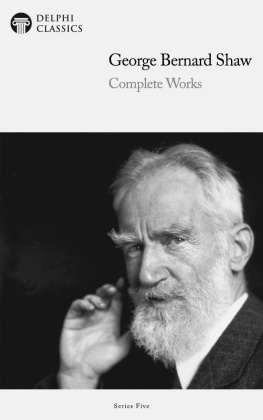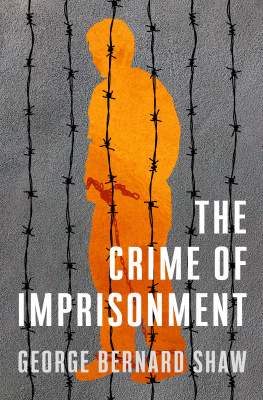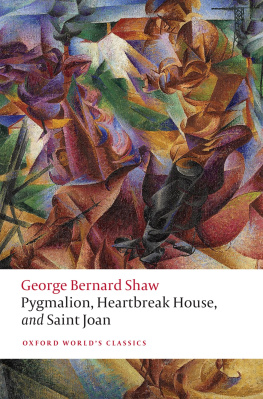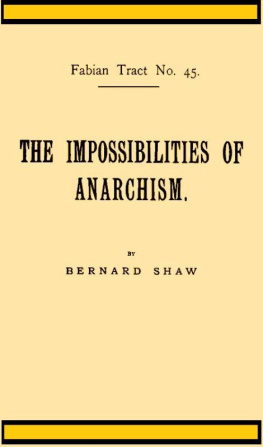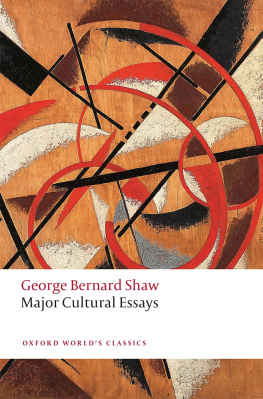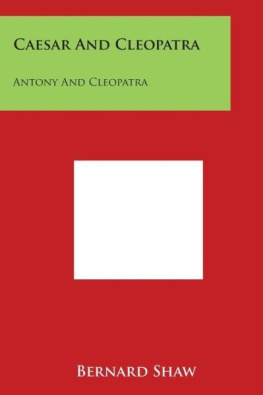
The Complete Works of
GEORGE BERNARD SHAW
(1856-1950)

Contents

Delphi Classics 2020
Version 2


Browse our Main Series

Browse our Ancient Classics

Browse our Poets

Browse our Art eBooks

Browse our Classical Music series

The Complete Works of
GEORGE BERNARD SHAW

By Delphi Classics, 2020
COPYRIGHT
Complete Works of George Bernard Shaw

First published in the United Kingdom in 2014 by Delphi Classics.
Delphi Classics, 2020.
All rights reserved. No part of this publication may be reproduced, stored in a retrieval system, or transmitted, in any form or by any means, without the prior permission in writing of the publisher, nor be otherwise circulated in any form other than that in which it is published.
Delphi Classics
is an imprint of
Delphi Publishing Ltd
Hastings, East Sussex
United Kingdom
Contact: sales@delphiclassics.com
www.delphiclassics.com
Parts Edition Now Available!

Love reading George Bernard Shaw ?
Did you know you can now purchase the Delphi Classics Parts Edition of this author and enjoy all the novels, plays, non-fiction books and other works as individual eBooks? Now, you can select and read individual novels etc. and know precisely where you are in an eBook. You will also be able to manage space better on your eReading devices.

The Parts Edition is only available direct from the Delphi Classics website.
Try free Parts Edition downloads
Interested in early twentieth century theatre?

Explore Playwrights at Delphi Classics
The Novels

Shaw was born in Synge Street, Portobello, Dublin

Plaque celebrating Shaws birth in Synge Street

Shaw as a young man
Immaturity

Shaw began to write his first novel Immaturity in 1879, but the work was not published by Constable and Company Ltd until 1930. It was the result of five months of labour and was met by a series of rejections from publishers, prompting the author to believe his work was of such poor quality that it deserved to be completely destroyed. He did not dispose of the novel, but he did wait nearly fifty years to return to the work and attempt to have it published. The novel centres on Robert Smith, a solitary young man, who has no family and few close friends. He becomes enamoured with two seemingly very different women: the aspiring young dressmaker Harriet and the exotic dancer at the music hall, Erminia Pertoldi. Smith completely misreads everything about Ms Pertoldi, highlighting his need to view the world and its inhabitants in absolute and polarized terms.
The title of the novel reflects the protagonists behaviour throughout the work and his inability to ever truly move beyond the realm of the imagination to engage with life in a meaningful capacity. Smith is described by his long-time friend as being neither a boy, nor a proper grown-up, but something else entirely. She berates him for living his life through his books and imagination, rather than actively involving himself in the real experience of living. Shaw based his central character on an immature version of himself, combined with a hero from one of his favourite childhood books. The novel certainly does not reflect Shaws greatest work, but it offers an interesting insight into the authors interests and talents as a young writer.

Shaw as an older man when Immaturity was published
CONTENTS
PREFACE

T HE SCENE OF one of Mr Arnold Bennetts novels is laid in a certain cul de sac off the Brompton Road, nearly opposite the West Brompton District Post Office. He calls it Alexandra Grove; but its actual name is Victoria Grove. As he describes it, the houses now contrive a double rent to pay, as the gardens have been fitted up with studios, thus quietly modernizing London by the back-to-back housing so vehemently denounced as a relic of barbarism in Leeds. When I arrived there as an Irish emigrant of 20, this intensification of population had not occurred. The houses were semi-detached villas with plenty of air space round them (you could call it garden). On the other side of the back wall were orchards; for the huge Poor Law Infirmary which now occupies this space, with its tower on the Fulham Road, was not yet built. The land between West Brompton and Fulham and Putney, now closely packed with streets and suburban roads, had still plenty of orchard and market garden to give it a countrified air and to make it possible to live there, as I did for years, without feeling that one must flee to the country or wither in the smoke. All the parallel Groves connected the Fulham Road with Kings Road, Chelsea, where Cremorne Gardens, an unlaid ghost from the eighteenth century, was desperately fighting off its final exorcism as a rendezvous of the half world. Hence these now blameless thoroughfares were then reputed Bohemian, whilst Victoria Grove, as a blind alley, remained as respectable as Clapham.
Next page
